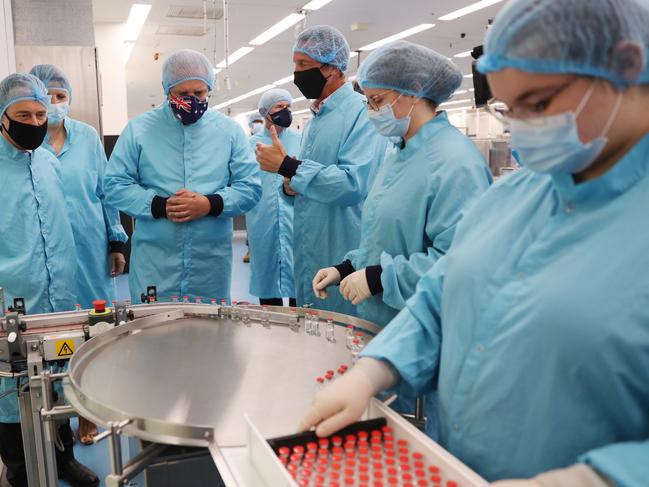Coronavirus vaccine rollout in Australia could breed jab resistant COVID-19 variants
Winter could pose a new threat to Australia’s successful COVID-19 strategy with full vaccination unlikely to happen in time.

Coronavirus
Don't miss out on the headlines from Coronavirus. Followed categories will be added to My News.
AUSTRALIA’S slow vaccine delivery schedule will make it difficult for the nation to be fully protected in time for winter when the virus is more likely to spread.
Recent evidence that the AstraZeneca vaccine works better if there is a three month time lag between doses means most Australians will not have time to get two doses before winter.
And it may also place strain on the government’s pledge to have the whole population vaccinated by October.
More concerning is expert warnings that a winter outbreak when the population is only partially vaccinated could help breed new variants resistant to vaccines.
“When the virus infects people who are only partially vaccinated or may not have developed immunity after vaccination (it) provides a great environment to mutate,” University of NSW infectious diseases expert Professor Mary-Louise McLaws told News Corp Australia.
Professor McLaws has calculated doctors will need to deliver 170,000 injections per day to cover 80 per cent of the population by October.

Sydney University immunisation expert Professor Robert Booy said because vaccines have not been approved for use in children around 20 per cent of the population will not be able to be vaccinated.
And if the Therapeutic Goods Administration recommends a three month time lag between doses of our main vaccine, people who receive their first dose later in the year may not be ready for their second dose by October.
“There’s no doubt that the virus prefers the cooler temperatures,” Professor Booy said but he said he did not believe having only part of the population vaccinated would be a big problem because a single dose of the AstraZeneca vaccine provided 76 per cent protection against severe disease.
Professor McLaws is calling for Australia to consider mixing and matching the Pfizer and AstraZeneca vaccines as is happening in the UK as a potential solution.

This might help speed up the vaccination program and perhaps ensure most people get one of the 20 million Pfizer shots the government has purchased.
The Pfizer vaccine is 95 per cent effective compared to AstraZeneca which is between 62 and 82 per cent effective.
“That’s a great strategy,” she told News Corp Australia.
“Perhaps that second dose can be Pfizer. That’s what I’d like to see. A priming, and then a better one,” she said.
Sydney University Immunisation expert Professor Robert Booy said before a mix and match strategy could be employed clinical trials must show it worked.
“Studies have started in Oxford, all over the UK, they’re doing the studies where you get Pfizer then AstraZeneca, Pfizer and Pfizer and Pfizer then AstraZeneca, 200 people in each group. They’ve already started recruiting, so that will give us some indication,” he said.
But he warned it was problematic to roll out the Pfizer vaccine widely because it needed to be kept at minus 70 degrees Celsius and some people had anaphylactic reactions to it.
Australia is relatively free of the virus but our one threat remains hotel quarantine.
“Our authorities are beholden to get control of any weaknesses in the quarantine program before the vaccine rollout and winter which may increase transmission speed because we stay indoors more,” Professor McLaws said.
The quarantine program was the only way cases could enter the Australian community, and the only way new more infectious and vaccine resistant variants of the virus could get a foothold here, she said.
“The likelihood of a speedy transmission and add winter – a wave would be catastrophic for controlling while attempting to vaccine the population,” she said.
The reason the virus is thought to spread faster during winter is the colder weather means people stay indoors increasing the risk of community spread.
However as Australian winters are not as cold as the northern hemisphere the risk may not be as great here as in the northern hemisphere, Professor McLaws said.
A spokesperson for the Health Minister Greg Hunt said: “Conditions relating to approval of the Astra Zeneca Vaccine are a matter for the TGA.
“Australia’s vaccination program has been based on the safety advice of the expert medical committee led by Professor Brendan Murphy and is on track to commence vaccination in late February.
“In addition, the program will commence with the most vulnerable as recommended by the Australian Technical Advisory Group on Immunisation through Phases 1A and 1B with the expectation that all members of 1a and 1b will have had the opportunity for vaccination completion or a first dose before the middle of the year,” he said.
More Coverage
Originally published as Coronavirus vaccine rollout in Australia could breed jab resistant COVID-19 variants





